We know what you're thinking—omnichannel marketing sounds fancy and expensive, right? But with economic uncertainty still on the horizon as we head into 2025, businesses are under more pressure than ever to do more with less.
The good news?
With the right approach and a bit of creativity, you can roll out a seamless omnichannel marketing strategy that’s both effective and budget-friendly.
Keep reading to learn how to navigate these challenges and create a strategy that works for your business in 2025 and beyond.
Table of Contents
First things first, let's make sure we're all on the same page. What exactly is omnichannel marketing? Simply put, it's a strategy that seamlessly integrates all your marketing channels to provide a cohesive and consistent experience for your customers.
Understanding Omnichannel Marketing
Picture this: your customers experience your brand in a harmonious and integrated way, whether they're browsing your website, scrolling through social media, or stepping into your physical location (if you have one). It’s about ensuring they get the same vibe and message from you, regardless of where they interact with your brand.
Now, you might be thinking, "But, isn't that just multichannel marketing?" Well, not quite. While multichannel marketing throws your message into several channels and hopes for the best, omnichannel marketing takes it a step further by ensuring that those channels work together harmoniously. It's all about creating a unified brand experience across every touchpoint. Telling the same story, ensuring your brand feels familiar and welcoming everywhere.
Did you know the countless benefits that come with a solid omnichannel strategy?
As we move into 2025, the emphasis on seamless integration across channels will only grow, making it crucial for businesses to prioritize an omnichannel approach.
Let's dive in and uncover them:
- Consistent Brand Presence: By maintaining a consistent brand image and messaging across all channels—whether it's your website, social media, email marketing, or physical stores—you establish trust and recognition among your audience. This consistency helps reinforce your brand identity at every touchpoint, leading to stronger brand recall and loyalty.
- Enhanced Customer Experience: Omnichannel approaches prioritize the customer experience by providing convenience and flexibility. Customers can engage with your brand through their preferred channels and seamlessly transition between online and offline touchpoints. For example, they might discover your products on social media, research further on your website, and make a purchase in-store or online—all without encountering any friction.
- Personalized Engagement: Leveraging data insights from various channels allows you to personalize the customer experience effectively. By understanding customer preferences, behaviors, and purchase history, you can tailor marketing messages, product recommendations, and promotions to each individual. This personalized approach fosters deeper connections with customers and increases the likelihood of conversion and repeat business.
- Data-Driven Decision-Making: Omnichannel strategies rely on robust data analytics to track customer interactions and measure performance across channels. By analyzing data metrics such as conversion rates, customer engagement, and attribution, you gain valuable insights into the effectiveness of each channel. Looking ahead to 2025, leveraging robust analytics tools will be even more critical, as businesses aim to track evolving customer behaviors and refine their strategies accordingly.
- Incremental Growth: Building a brand and driving sales brick by brick through omnichannel strategies involves nurturing relationships with customers over time. Each interaction—whether it's a social media engagement, an email newsletter, or an in-store visit—contributes to the customer's journey and moves them closer to making a purchase. Over time, these incremental engagements accumulate, leading to sustained growth in brand awareness, customer loyalty, and sales revenue.
Crafting Your Omnichannel Strategy
So, how can you craft an omnichannel marketing strategy with a small budget? Let's look at actionable steps broken down by each stage of the marketing funnel:
Upper Funnel Strategy:
In the upper funnel stage, the focus is on capturing the attention of a broad audience and building brand awareness. Here's how to strategically engage potential customers at this initial stage:
Know Your Audience
Know Your Audience: The foundation of any successful marketing strategy is a deep understanding of your target audience. Who are they? What are their pain points? Where do they hang out online? By answering these questions, you can tailor your messaging and choose the most effective channels to reach them.
- Trends and Preferences: identify emerging trends, pain points, and the language your customers use, which can inform both your product development and marketing messaging. Here are some tools you can use:
Google Trends
What it's for: Google Trends shows you the popularity of search queries over time. It's invaluable for spotting emerging trends or declining interests.
How to use it: Navigate to Google Trends, enter a keyword, and analyze the trends. You can filter by time, location, and category for more detailed insights.
Example: Considering adding a new line of gluten-free products? Type "gluten-free recipes" into Google Trends to gauge interest levels and seasonality, helping you time your launch perfectly.
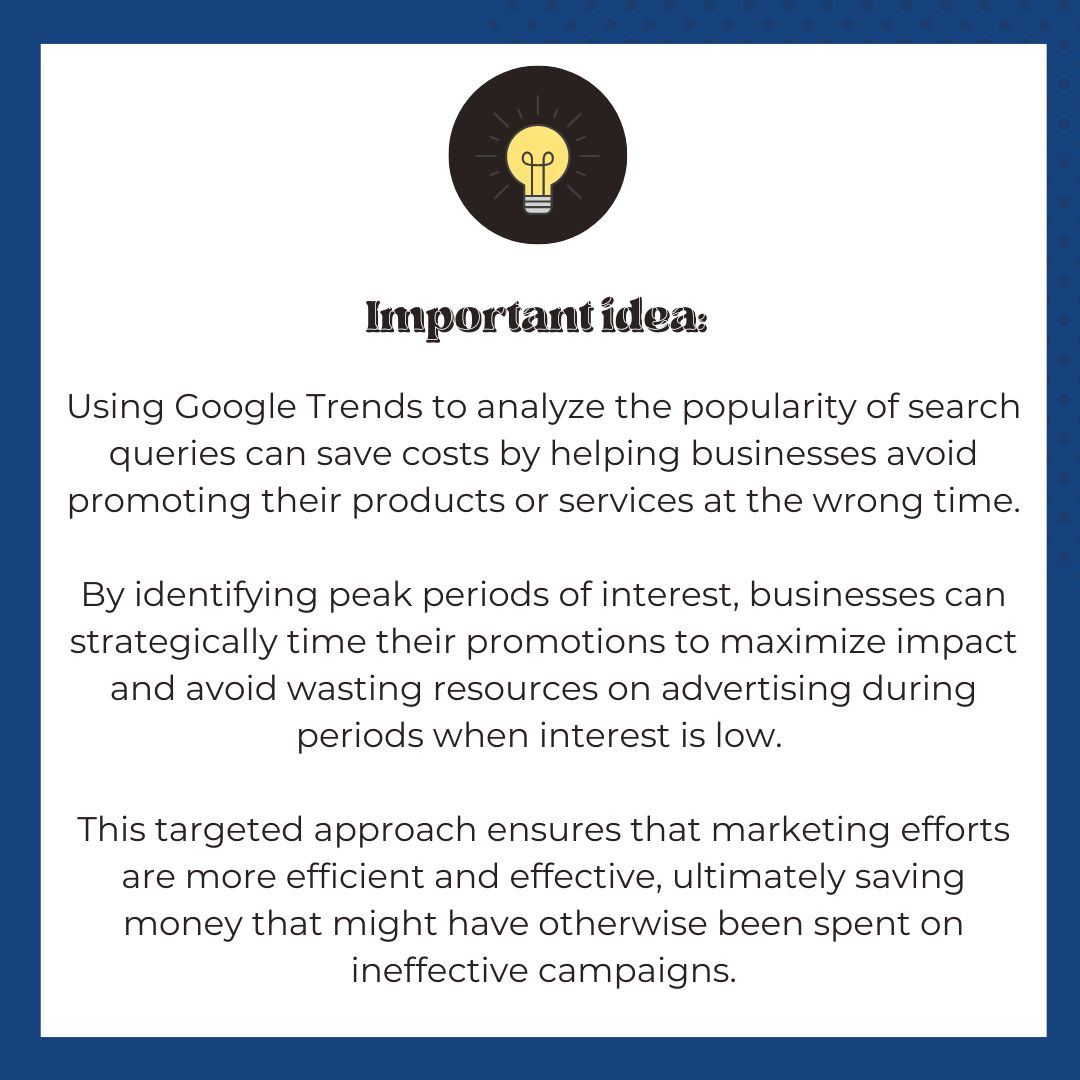
Google Keyword Planner
What it's for: Google Keyword Planner helps you find the right keywords for SEO and paid search campaigns by providing search volume, competition, and related keywords.
How to use it: Access it through a Google Ads account. Enter your seed keywords to get data on search volume and related keyword suggestions.
Example: If you're optimizing your bakery's website, use "artisan bread" as a search term to find related queries like "organic sourdough" or "whole grain rye," which can guide your content and SEO strategy.
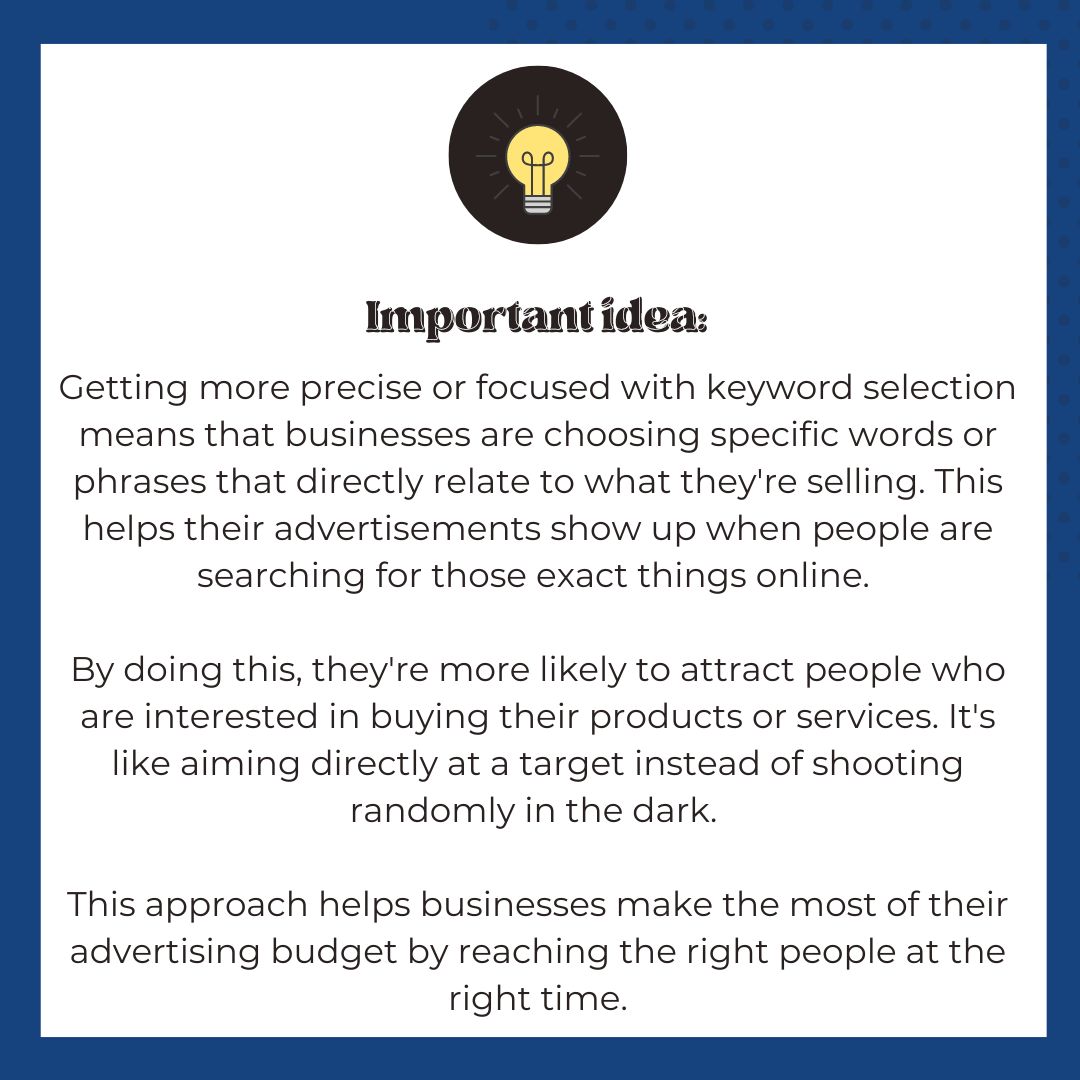
Ahrefs
What it's for: Ahrefs is a comprehensive search engine optimization (SEO) tool for tracking rankings, analyzing competitors, and researching keywords. It's great for enhancing your online visibility and SEO strategy.
How to use it: Start with a site audit to understand your search engine optimization (SEO) health, then use the keyword explorer for research and the site explorer to analyze competitors' strategies.
Example: Imagine your website is like a store in a big city, and search engines are like the roads people use to find stores. SEO is like putting up signs on those roads, so more people can find your store without you having to pay for ads all the time.
Or It's like planting seeds in your garden. When you take the time to plant the right seeds and care for them, they grow into healthy plants that keep producing fruits and vegetables without you having to buy new seeds every time.
By spending time on SEO and choosing the right words or phrases that people actively search for, your website can climb up those search engine roads. This means more people will see your store and visit it, bringing you customers without you having to pay for ads all the time.
So, just like taking care of your garden leads to a lot of food over time, investing time in SEO leads to more customers finding your website, bringing you business without constantly spending money on ads.
Mid-Funnel Strategy:
Moving beyond awareness, the mid-funnel stage focuses on nurturing leads and guiding them toward consideration. Here are strategies to effectively engage with potential customers in this stage:
- Segmentation Mastery: Start with segmenting your audience based on available data. This involves not just basic demographics, but also online behaviors, and purchasing patterns. For instance, use analytics tools to identify which segments of your audience are most responsive to your current marketing efforts and which platforms they frequent. This data-driven approach allows for more targeted and therefore cost-effective advertising strategies.
- Leveraging Analytics for Insight: Platforms like Google Analytics offer a wealth of information about your audience's online behavior. Look at metrics like page views, bounce rate, and conversion paths to understand what content resonates with your audience and where they drop off. This insight is crucial for tailoring your messaging and choosing the right channels to invest in, ensuring you're not wasting your limited budget on ineffective strategies.
- Competitor Audience Analysis: Understanding your competitors' audience can also offer valuable insights. Analyze their marketing strategies and audience responses to identify gaps in their approach that you can capitalize on. Tools like SEMrush and Ahrefs can provide competitive intelligence that helps you understand where there might be opportunities to attract an audience underserved by your competitors.
For example, here is a scenario, if you’re marketing for a food brand and targeting health-conscious millennials:
- Know Your Audience:
Get to know health-conscious millennials' passion for nutrition and sustainability in food. Choose platforms like Instagram and TikTok, where they love to share and discover delicious, healthy recipes and sustainable eating tips.
- Engagement and Interaction Analysis:
Keep an eye on likes, comments, and shares to see what food content gets their taste buds tingling. By learning what they love and crave, you can serve up more of what they enjoy and keep them engaged.
- Customer Feedback and Direct Interaction:
Chat with them directly through comments, messages, and surveys about their favorite foods and cooking hacks. Their feedback helps you tweak your messages to better suit their tastes and preferences.
- Trends and Preferences:
Notice how health-conscious millennials drool over food content on platforms like Instagram and TikTok? By staying on top of the latest food trends and dietary preferences, you can keep your marketing fresh and appealing to them.
These connections show how understanding your audience, analyzing engagement, gathering feedback, and keeping up with trends help us craft a marketing strategy that resonates.
This way, you're not just throwing content out there but serving up the tasty, visual treats they crave, right where they love to hang. It's all about making your marketing dollars work smarter, not harder, to charm this vibrant crowd.
Bottom Funnel Strategy:
In the bottom funnel stage, the focus shifts towards driving conversions and encouraging purchase decisions. Here's how to effectively engage with potential customers who are ready to convert:
- Engagement and Interaction Analysis: Pay close attention to how your audience engages with your content across different platforms. Which types of posts generate the most interaction? Do certain topics or formats (videos, blogs, infographics) perform better? This level of engagement analysis can guide you in creating more of the content that your audience values, leading to higher engagement rates for a lower cost.
Here are some examples of what you can get by using GA4 and Shopify in your marketing strategy:
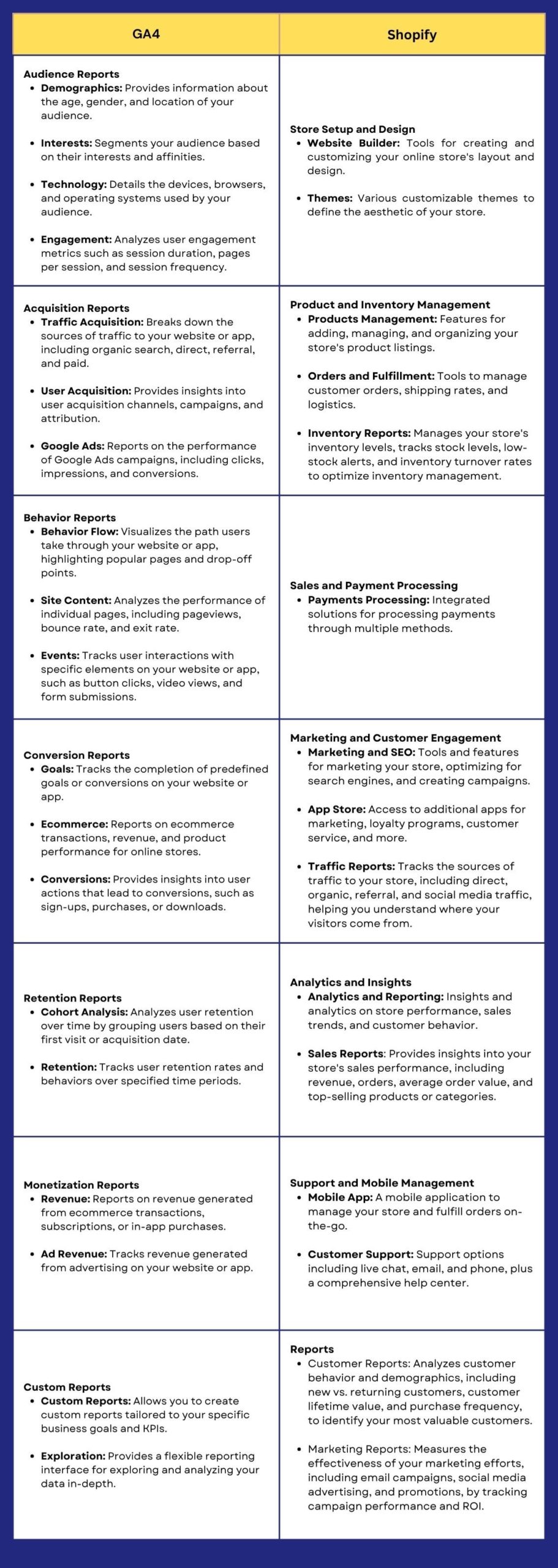
With the information that GA4 can provide, you can target your marketing efforts better, even if you don't have a big budget. It's like having a map to guide you through the maze of digital marketing, helping you make smart decisions and get the most out of your resources.
- Customer Feedback and Direct Interaction: Never underestimate the value of direct customer feedback. Surveys, feedback forms, and even direct conversations on social media can provide deep insights into your audience's needs and preferences. Tools like SurveyMonkey or Google Forms offer cost-effective ways to gather this information. Additionally, monitoring comments and direct messages across your platforms can offer unfiltered insights into what your audience thinks and feels.
But you might be asking yourself: What do I do with this information? Here are some benefits of making the most of customers’ feedback:
- Product Improvement: By gathering feedback from customers, businesses can identify areas for product improvement, leading to enhancements that better satisfy customer needs. This boosts customer satisfaction and loyalty, increasing repeat purchases and referrals, and ultimately driving revenue growth.
- Cost Reduction: By addressing customer concerns or preferences identified through direct interaction, businesses can prevent potential negative impacts on sales or reputation that could result in costly damage control efforts.
- Increased Referrals: Satisfied customers are more likely to recommend the business to others, generating new leads and sales without additional marketing expenditure.
Choose the Right Channels
Choose the Right Channels: With a limited budget, you'll need to be strategic about which channels you invest in. Focus on the ones where your audience is most active and where you can achieve the highest ROI. This might include social media, email marketing, content marketing, and search engine optimization (SEO).
Upper Funnel (Awareness):
In the upper funnel stage of awareness, strategically selecting channels becomes vital to effectively engage potential customers. Here's how to navigate this crucial stage and ensure your brand stands out amidst the digital noise:
- SEO. Begin by focusing on search engine optimization (SEO) to ensure your brand and products are discoverable to potential customers. Optimize your website content and structure to improve visibility on search engine results pages (SERPs) and attract organic traffic.

By incorporating AI platforms like ChatGPT into your SEO strategy, you can streamline keyword research and content optimization processes, making it easier for one person to execute SEO initiatives effectively. Let me know if this aligns with your preferences or if you'd like further adjustments!
- Pay-Per-Click (PPC) Advertising: Implement a strategic PPC campaign to target specific keywords and audience segments. Optimize your PPC strategy by focusing on high-converting keywords and audience demographics. Consider using remarketing tactics to re-engage users who have previously visited your website.
Here is how to do it:
- Conduct Keyword Research: Identify relevant keywords with high search volume and low competition.
- Target Specific Audience Segments: Use demographic and interest targeting to reach your ideal customers.
- Optimize Ad Copy and Landing Pages: Craft compelling ad copy and create dedicated landing pages optimized for conversion.
- Monitor and Adjust: Continuously monitor the performance of your PPC campaigns and make adjustments based on key performance indicators (KPIs) such as click-through rates (CTR) and conversion rates.
Mid Funnel (Consideration):
Moving into the mid-funnel stage, the focus shifts towards nurturing potential customers who have shown initial interest in your brand. Strategies in this stage aim to provide more information and guide prospects as they consider their options.
- Product Seeding and Influencers: Utilize product seeding and influencer partnerships to amplify your brand's reach and credibility. Identify influencers who resonate with your target audience, and collaborate with them to promote your products to their followers.
- User-Generated Content (UGC) and Small Paid Social Campaigns: Leverage user-generated content platforms like Billo.app to source authentic content created by your customers. Incorporate this UGC into your social media campaigns to increase engagement and trust. Consider running small paid social campaigns to amplify the reach of your UGC content. Explore opportunities like TikTok Shop affiliate programs for additional exposure.
Here's how Billo.app can amplify your brand with user-generated content:
What it is: Billo.app is a user-friendly online platform designed to help businesses collect and manage user-generated content (UGC). It provides a simple and organized way for brands to gather photos and videos from their customers, which can then be used in various marketing materials.
How to use it: Sign up for Billo.app and create your brand profile. Encourage your customers to share their experiences with your products or services by submitting photos and videos through the platform. Once the content is collected, you can easily review and curate the submissions, selecting the best ones to feature in your marketing campaigns.
Example: Let's say you run a small bakery. You can use Billo.app to invite your customers to share pictures of themselves enjoying your delicious pastries or cakes. By showcasing these photos on your website or social media pages, you can create a sense of community around your brand and inspire others to visit your bakery.
- Organic Paid Social: Use organic paid social strategies to build brand awareness and foster meaningful connections with your audience. Create compelling social media content that resonates with your target demographic and encourages interaction and sharing.
Here's how to elevate your brand and engage your audience using organic paid social strategies:
- Create Great Content: Make content that your audience loves, like informative posts or behind-the-scenes glimpses.
- Know Your Audience: Understand what your audience likes and cares about.
- Use Fun Features: Try out features like polls and challenges to get people involved.
- Keep Posting Consistently: Stick to a schedule so your audience knows when to expect new content.
- Encourage Sharing: Run contests or giveaways to get people sharing your posts with their friends.
- Chat with Your Fans: Respond to comments and messages to show your audience you care.
- Keep Learning: Watch how your posts perform and adjust your strategy based on what works.
Even with limited resources, organic paid social strategies empower you to make a significant impact and foster meaningful connections with your audience
Bottom Funnel (Conversion):
Advancing to the bottom funnel stage, the primary goal is to convert leads into paying customers and drive tangible results. Strategies at this stage focus on facilitating the decision-making process, removing barriers to purchase, and incentivizing action to drive conversions and achieve measurable outcomes.
- Conversion Rate Optimization (CRO): Implement A/B testing on landing pages to optimize conversion rates and lower customer acquisition costs (CAC). Experiment with different design elements, copy, and calls-to-action to identify the most effective combinations.
- Subscription/Save Programs: Introduce subscription or save programs to increase customer lifetime value (LTV) and improve profit margins. Offer incentives for customers to subscribe to recurring purchases, such as discounts or exclusive perks.
For example, a food brand with a combined approach might bring these benefits:
- Social media (particularly Instagram), acts as the visual appetizer:
- Engages audiences with eye-catching images of products.
- Fosters a community through likes, comments, and shares.
- PPC (Pay-Per-Click), acts as the main course:
- Directly targets those searching for what you offer.
- Ensures brand appears at the top of the menu when it matters most.
- Offers flexibility of cost control based on performance.
- SEO (Search Engine Optimization), acts as the dessert:
- Organically boosts visibility in search engine results for food-related queries.
- Ensures a steady stream of traffic hungry for content.
- Email marketing:
- Offers exclusive recipes and promotions.
Together, these strategies create a well-rounded digital marketing banquet that:
Attracts, engages, and converts the target audience.
But, are you struggling to determine the optimal allocation of your marketing budget across different channels? Let's explore the key factors to consider for achieving a balanced and effective distribution of resources:
Allocating your marketing budget across channels demands careful consideration beyond audience distribution. While favoring channels with a larger audience may seem logic, a strategic balance is crucial. Here are key factors to guide your allocation decisions:
- Channel Costs: Consider the cost of advertising and promotion on each channel. Some channels may require higher investments to achieve desired results, while others may offer more cost-effective options. Evaluate the cost per acquisition or cost per conversion for each channel to determine where the budget can be allocated most efficiently.
- Channel Objectives: Align the budget allocation with the objectives of each marketing channel. For example, if the goal of a particular channel is to drive brand awareness, a larger portion of the budget may be allocated to channels that excel in this area, such as social media and display advertising. On the other hand, if the objective is to drive conversions, channels with a proven track record of delivering high conversion rates may justify a larger investment.
- Testing and Optimization: Allocate part of the budget for testing and experimentation to identify which channels and strategies yield the best results. Conduct A/B tests, experiments, and pilot campaigns to gather data and insights that inform future budget allocations. Continuously optimize the allocation of resources based on performance data and evolving business goals.
Leverage Free and Low-Cost Tools
In today's fast-paced digital world, effective marketing doesn't have to cost a fortune. Thanks to a wide range of free and affordable tools, small businesses and entrepreneurs can amplify their marketing efforts without breaking the bank.
Take social media management, for instance. Platforms like Hootsuite and Buffer offer free plans that enable scheduling, tracking, and managing multiple accounts—all essential features for maintaining a strong online presence. Similarly, email marketing services like Mailchimp and Sendinblue provide affordable solutions for creating professional campaigns, complete with customizable templates and advanced analytics.
By taking advantage of these tools, businesses can streamline their marketing efforts, engage with their audience, and drive growth—all while staying within budget. Don't let financial constraints hold you back from marketing success!
Create Consistent Branding
Create Consistent Branding: Consistency is key when it comes to omnichannel marketing. Make sure your branding is cohesive across all channels, from your website and social media profiles to your email campaigns and digital ads. This will help reinforce your brand identity and make it easier for customers to recognize and engage with your brand.
Upper Funnel (Awareness):
As you embark on creating brand awareness, weaving consistency throughout your branding channels is key to crafting a cohesive and memorable identity. Here's how to nurture a unified brand presence that speaks to your audience:
- Visual Identity: Start with a consistent visual identity across all platforms. This means your logo, color scheme, typography, and imagery should be uniform from your website to your social media, email campaigns, and digital ads. Like a signature dish, your visual branding should be instantly recognizable, making your brand stand out in the crowded digital marketplace.
Mid-Funnel (Consideration):
Transitioning into consideration, maintaining brand consistency is crucial for trust-building. Let's delve deeper into how you can ensure your brand maintains a unified look and feel to foster recognition and reliability throughout the decision-making process.
- User Experience: The consistency should extend to the user experience as well. Navigating your website, interacting with your mobile app, or clicking through from a PPC ad to a landing page should all feel cohesive. This doesn’t mean every channel needs to look the same, but the transition between them should be fluid, without any jarring changes in design or functionality. It’s about crafting an experience that carries the essence of your brand across every touchpoint.
Crafting consistent branding across your omnichannel marketing efforts is crucial, especially when working with a lean budget. It's about making every penny count by ensuring your brand's presence is unmistakable, whether a customer is scrolling through Instagram, reading an email, or clicking through from a PPC ad. This strategic consistency maximizes brand recognition and trust without the need for hefty advertising spends.
Bottom Funnel (Conversion):
As you approach the bottom stage of conversion, reinforcing brand consistency becomes useful in sealing the deal with potential customers. Let's explore how you can uphold a unified brand presence to instill confidence and drive conversions effectively. Here are some ideas if you have a limited budget:
- Leverage Existing Assets: Utilize what you already have. Design a set of brand guidelines that cover your visual identity, tone, and messaging. This one-time investment ensures that all future content, whether for social media, email, or ads, aligns with your brand, creating a cohesive experience at no extra cost.
- Smart Repurposing: Get creative with your content across channels. A single piece of content can be repurposed into multiple formats. For example, a blog post on your website can be broken down into several social media posts, an email newsletter topic, and even inspire PPC ad copy. This approach amplifies your reach across channels while keeping costs low.
- Unified Customer Experience: A seamless brand experience, from social media to your landing page, reduces friction and improves conversion rates. When customers know what to expect from your brand, they're more likely to engage, regardless of the channel they come from. This consistency ensures that the investment in driving traffic to your site or social profiles pays off, optimizing your limited marketing budget.
In essence, for businesses operating on tight budgets, consistent branding across all marketing channels isn’t just a best practice—it’s a cost-effective strategy that enhances brand recognition, builds trust, and optimizes conversion rates. By smartly leveraging assets, repurposing content, and maintaining a unified brand experience, you can achieve impactful marketing results without the need for substantial financial investment.
For example, imagine you're marketing a food brand that prides itself on its commitment to organic, locally sourced ingredients, all while navigating a tight budget. Here's how you can stretch every marketing dollar:
- Leverage Existing Assets: Start by crafting comprehensive brand guidelines covering not just visual identity, but also the tone and messaging that encapsulate your brand's dedication to quality food. This one-time investment ensures that all future content across social media, email, and ads aligns seamlessly with your brand, creating a mouthwatering experience at no additional cost.
- Smart Repurposing: Get creative with your content strategy. Take a single piece of content, like a blog post about your commitment to local sourcing, and repurpose it into bite-sized social media posts, engaging email newsletter topics, and compelling PPC ad copy. This approach maximizes your reach across channels while minimizing expenses.
- Unified Customer Experience: Craft a consistent brand experience that's as delightful as your signature dish. Whether customers encounter your brand on social media, through email, or on your website's landing page, ensure they're greeted with the same inviting aroma and mouthwatering visuals. This consistency optimizes your limited marketing budget by ensuring that every effort to drive traffic turns into a satisfying conversion.
This consistency not only reinforces your brand's commitment to quality and sustainability but also cultivates a strong, loyal community around these shared values. By strategically aligning your messaging across platforms, you ensure that your budget is used effectively, making every marketing dollar work harder to build a cohesive and compelling brand story that attracts and retains customers who are passionate about the same ideals.
Personalize the Customer Experience
Personalize the Customer Experience: One of the benefits of omnichannel marketing is the ability to deliver personalized experiences to your customers. Use data and analytics to segment your audience and tailor your messaging accordingly. Whether it's sending personalized email recommendations or retargeting ads based on browsing behavior, personalized communication can go a long way in driving conversions.
For example, you can utilize email segmentation based on customer behavior and preferences. This can be done using data from past purchases, email engagement rates, and website interactions.
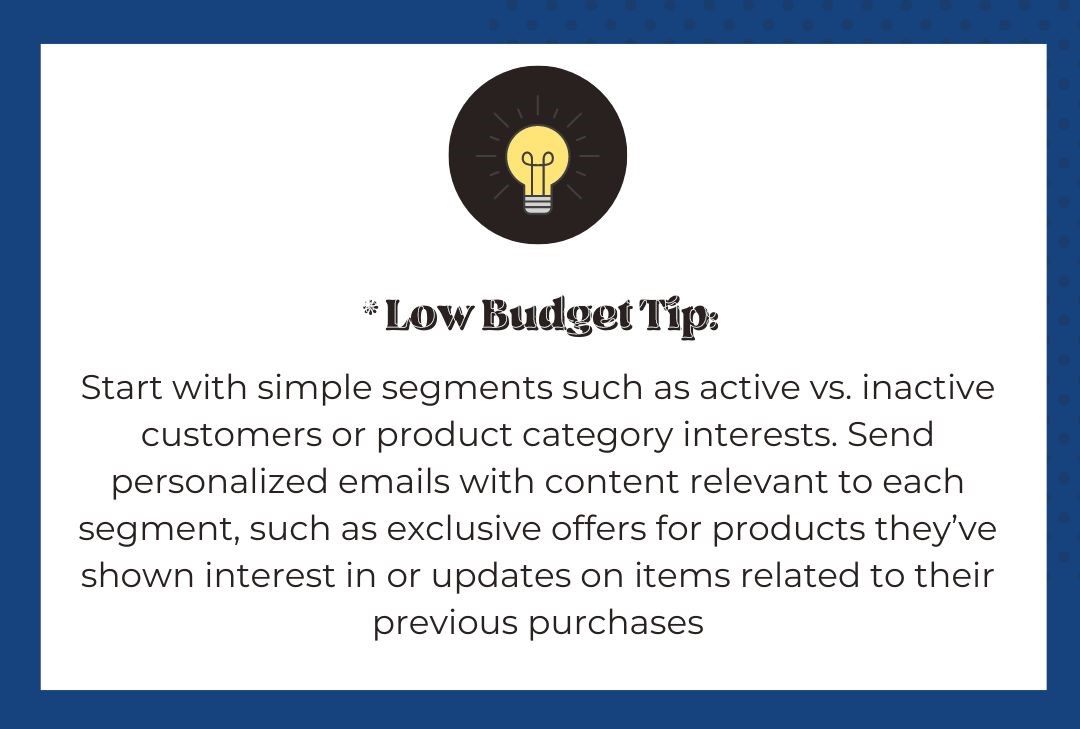
You can also tailor your social media content and ads to reflect the interests and behaviors of different audience segments. Use insights from platforms like Facebook and Instagram to understand which topics and types of content resonate with your audience.
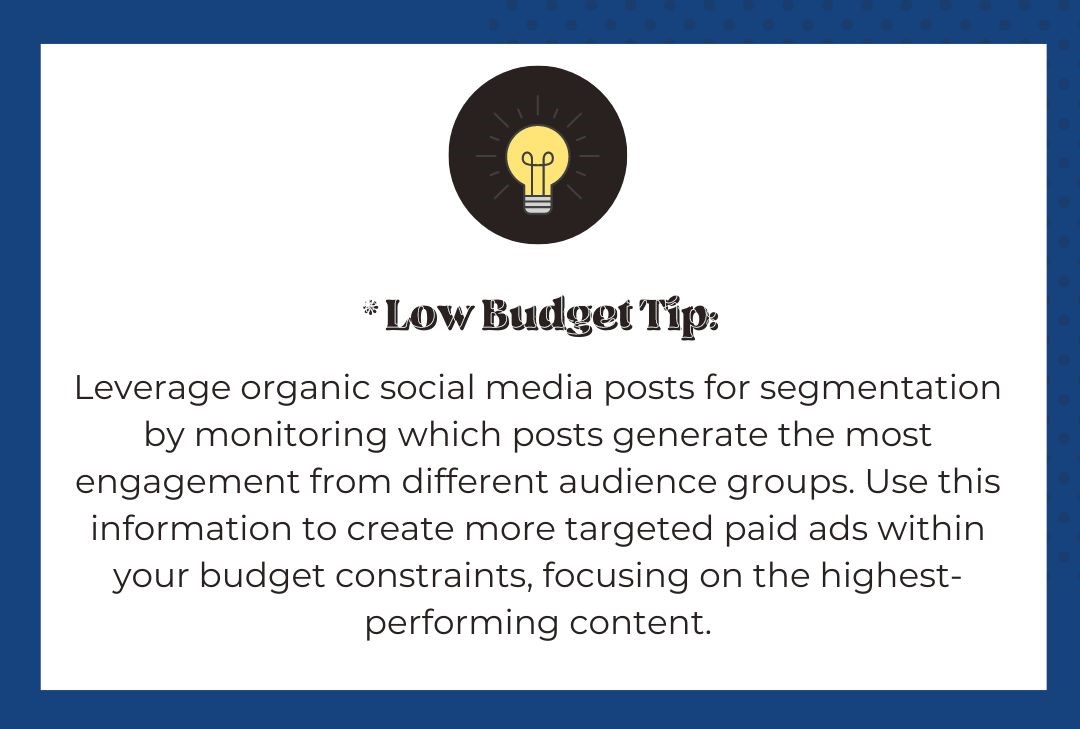
Additionally, you can implement retargeting campaigns to show ads to users who have visited your website but didn’t make a purchase. Use Google Ads and social media advertising platforms to set up retargeting based on specific product pages visited.
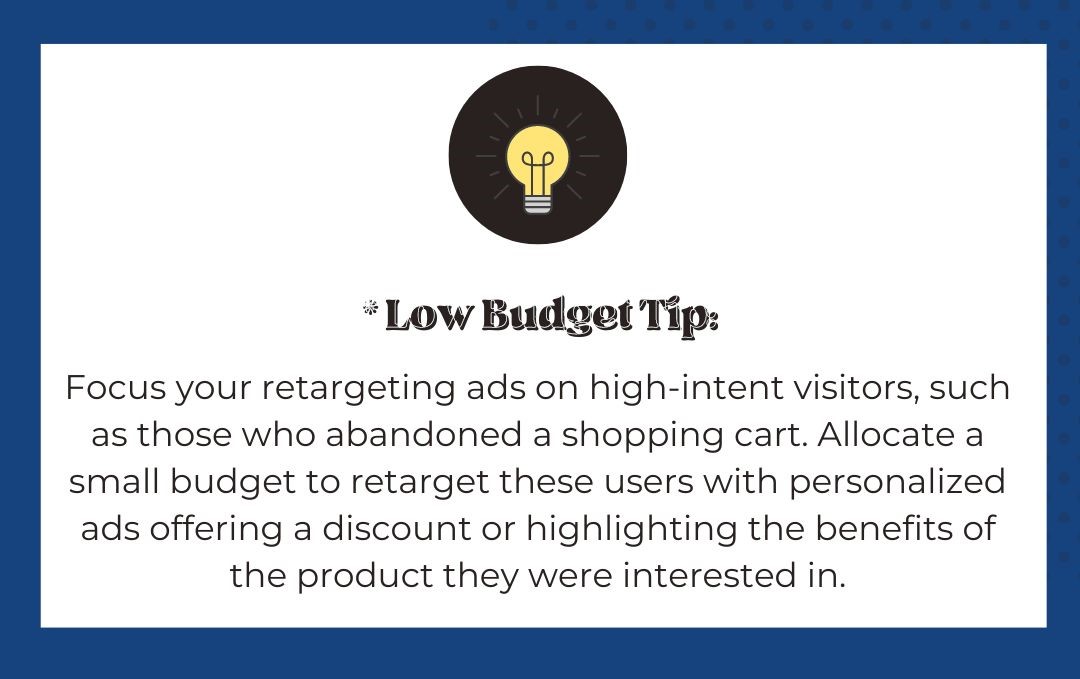
For instance, a food brand can personalize its messaging based on customer preferences, dietary restrictions, and past purchase history to offer relevant product recommendations and discounts.
Measure and Optimize
Measure and Optimize: Finally, don't forget to measure the performance of your omnichannel campaigns and optimize accordingly. Track key metrics such as website traffic, conversion rates, and customer engagement to see what's working and what's not. Use this data to refine your strategy and allocate your budget more effectively.
Diving deeper into the process of measuring and optimizing omnichannel campaigns, it's crucial to adopt a data-driven mindset to continually enhance your marketing efforts. Here's how to approach this in a detailed and actionable way:
Upper Funnel (Awareness):
In the initial phase of creating awareness, measuring and optimizing your efforts is essential for refining your strategies and maximizing impact. Let's explore how you can effectively track performance and make data-driven adjustments to ensure your brand gains traction and visibility:
- Establish Clear KPIs. Begin by defining what success looks like for each channel within your omnichannel strategy. This might include specific goals for website traffic, email open rates, social media engagement, PPC click-through rates (CTR), and conversion rates. By setting these key performance indicators (KPIs), you create a benchmark to measure against, ensuring that you're not just collecting data but analyzing it with purpose.
- Utilize Comprehensive Analytics Tools. Leverage Free or Low-Cost Analytics Tools: Utilize free analytics tools such as Google Analytics for comprehensive insights into website performance and social media platforms' built-in analytics to track engagement and reach. These tools can provide a wealth of data without additional costs, allowing for effective monitoring of your omnichannel campaigns, offering insights into traffic, user behavior, and conversion paths.
Mid Funnel (Consideration):
As customers consider their options, it's important to measure and improve what you're doing. Let's see how keeping track and making things better can help guide people towards making a decision.
- Conduct Regular Audits. Schedule regular audits of your omnichannel campaigns to assess their performance against your KPIs. These audits should look at which channels are driving the most value, where customers are engaging with your brand most, and which touchpoints are leading to conversions. This is also an opportunity to identify any discrepancies in your data or areas where customer experience may be disjointed.
The frequency of conducting regular audits can vary depending on various factors such as the size of your business, the complexity of the omnichannel strategy, and the pace of change in the industry. However, a common recommendation is to conduct audits quarterly or bi-annually.
Quarterly audits provide a good balance between staying proactive and not overwhelming your strategies with too frequent changes. This timeframe allows enough time to gather sufficient data and make meaningful adjustments to the strategy while also ensuring that the business remains agile in responding to changes in the market.
For businesses operating in fast-paced industries or experiencing rapid growth, more frequent audits, such as monthly or bi-monthly, may be appropriate to ensure that the omnichannel strategy remains aligned with evolving business goals and customer preferences.
Ultimately, the optimal frequency of audits should be determined based on the specific needs and circumstances of your business, with the flexibility to adjust as necessary to maintain effectiveness in optimizing omnichannel performance.
- A/B Testing. Implement A/B testing across channels to optimize your marketing messages, design elements, and calls-to-action (CTAs). Even on a limited budget, A/B testing can be highly informative. For example, test different email subject lines to see which results in higher open rates, or experiment with ad creatives on PPC campaigns to find the most effective imagery and copy. A/B testing provides concrete data on what resonates with your audience, allowing you to make informed decisions that enhance campaign performance.
Bottom Funnel (Conversion):
As you aim for conversions, measuring and improving your strategies is crucial for closing deals with potential customers. Let's dive into how you can effectively track performance and refine your approach to drive successful conversions and boost your bottom line:
- Focus on Organic Growth Strategies: Enhance efforts on channels that require more time investment than financial, such as SEO and organic social media growth. For instance (This will include) optimizing website content for search engines and engaging actively with your community on social media to build brand awareness and loyalty at a minimal cost.
- Allocate Budget Based on Performance. Use the insights gathered from your analytics and testing to allocate your marketing budget more effectively. Invest more in the channels and tactics that are delivering the best ROI, and consider scaling back or optimizing those that are underperforming. This might mean reallocating funds from a less effective social media platform to a more successful PPC campaign or increasing your investment in email marketing due to its high engagement rates.
To ensure optimal use of a limited marketing budget, it's crucial to continuously monitor the performance of your campaigns across all channels. This constant evaluation allows you to quickly identify which tactics are most effective in driving conversions. This agile approach to budget management ensures that you're always investing in the channels that deliver the highest return, maximizing the impact of your marketing efforts even with financial constraints.
- Promote a Culture of Continuous Improvement. Optimization is not a one-time task but an ongoing process of refinement. Encourage a culture of continuous improvement within your team, where data is regularly reviewed, and strategies are adapted based on what's working. This approach ensures your omnichannel marketing efforts remain agile, responsive to customer behavior, and aligned with your business goals.
To adeptly measure and optimize omnichannel campaigns, especially under the constraints of a tight budget, it’s essential to focus on strategies that offer the highest return on investment with minimal spend
By meticulously measuring and optimizing your omnichannel campaigns, you not only improve their effectiveness but also ensure your marketing budget is being used as efficiently as possible. This ongoing cycle of analysis, testing, and refinement is key to driving sustained growth and maintaining a competitive edge in your market.
As 2025 approaches, navigating the world of omnichannel marketing on a tight budget may sound like a tricky adventure, but it's totally doable and can be surprisingly fun! By getting to know your audience like the back of your hand, choosing the right places to share your story, making the most of both free and budget-friendly tools, keeping your brand's look and feel the same everywhere, and tailoring messages just for your customers, you can create a marketing strategy that really hits the mark.
Remember, the secret sauce is in measuring how well things are going and being ready to tweak your plan to keep getting better results. This strategy shows that even with a few dollars in your pocket, you can reach out and connect with your customers in meaningful ways across all channels. So, armed with data, creativity, and a focus on what your customers truly value, you're all set to make a big impact, proving that great marketing doesn't always have to come with a big price tag.
